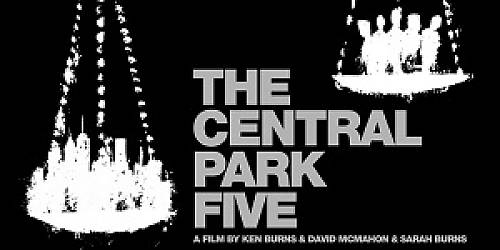 Hopefully you caught PBS’s Tuesday night broadcast of the Central Park Five – if not, I highly recommend it. Ken Burns remains among the finest contemporary documentarians, presenting the story of five teenagers in late 1980s New York who were railroaded into providing false confessions and ultimately wrongfully convicted of committing one of the most horrific non-murders one can imagine.
Hopefully you caught PBS’s Tuesday night broadcast of the Central Park Five – if not, I highly recommend it. Ken Burns remains among the finest contemporary documentarians, presenting the story of five teenagers in late 1980s New York who were railroaded into providing false confessions and ultimately wrongfully convicted of committing one of the most horrific non-murders one can imagine.
Ken Burns did a masterful job of setting the scene, as author Eisa Nefertari Ulen, writing in the Washington Post on Tuesday, notes, “New York was just emerging from the near-bankruptcy of the 1970s and entering a period of lavish conspicuous consumption that was fueled by Wall Street in the 1980s. Black culture was just emerging from the empowerment of the Black Power Movement of the 1970s and entering a period of disenfranchisement that was fueled by the Crack Era of the 1980s.”
Antron McCray, Korey Wise, Kevin Richardson, Yusef Salaam, and Raymond Santana, all between 14 and 16 at the time, were all in the Park that night and they were causing trouble, but they clearly did not commit the crime.
As the documentary described, they were being questioned on other assaults that occurred that night, when the police found the victim in this case, badly beaten with multiple skull fractures, raped, and near death. She survived, but has no memory of the attacks and fought hard to fully recover.
The police made classic mistakes – they assumed that these boys, who were there, were the same ones who attacked the woman. They used those assumptions to extend their detention, holding the boys for hours without access to counsel, often either away from their parents or misleading the parents into believing if they just told them what they wanted to hear, they would be let go.
These were teenagers, from working class backgrounds, whose parents were not sophisticated or educated. And so, on camera, the boys admitted to a crime that they did not commit.
As media coverage noted, “At their trial, the suspects said their confessions had been coerced and, though prosecutors had little other evidence, a jury convicted the five defendants.”
As Ken Burns shows, the police made a classic error in how they handled the case. They forced a confession and, once they did so, they began to ignore serious problems with the case.
The first red flag came back when their DNA profiles – and DNA testing in 1989 was in its infancy – did not match the DNA found on the victim. That should have alerted authorities right there that they had a problem.
Moreover, the timeline that the police constructed with the boys did not place them at the scene of the crime. Instead, at the time of the woman’s attack, which they were able to pinpoint, the boys were at a different scene – and this was known because they were involved in an assault on an unrelated victim.
As longtime New York DA Robert Morgenthau recounted, it was only because of DNA testing that it was possible to reexamine the evidence.
When they retested the DNA, they were able to tie semen found at the crime scene, not to the five boys who were convicted, but to a sixth person, a man named Matias Reyes.
On December 4, 2002, it was reported, “Manhattan District Attorney Robert Morgenthau is expected to ask a judge Thursday to vacate the convictions of the five men found guilty in the April 1989 brutal rape and beating of a 28-year-old jogger in Central Park and other attacks that night.”
Despite the lack of evidence outside of the confessions, Ken Burns noted that the prosecutor who tried the case, as well as the police, still believed the boys were involved.
Reported ABC News in 2002, “Some law enforcement officials believed that the five defendants are still guilty of other crimes that fateful night. Police said the Central Park rape was part of a rampage of 12 random attacks by a gang of as many as 40 black and Hispanic youths who were participating in the ‘wilding’ spree.”
The report continues, “Morgenthau will ask that all the convictions be vacated, even though sources told ABCNEWS the Manhattan District Attorney’s office still believed the five men are guilty of those other crimes and that those convictions should stand. There is no evidence of the police or prosecutorial misconduct [as] the five suspects have alleged in the case, the sources said.”
“Detectives who were involved in the Central Park jogger rape investigation still believe the five defendants were somehow involved in the attack and that Reyes was with them. They just disagree over whether he was with the teens during the rape or whether he attacked the jogger after the others,” the report continued.
“I believe these kids did it. They said they did it,” said Bert Arroyo, who was the lead detective on the case.
“The videotapes speak for themselves,” he said, referring to videotaped confessions made by the defendants.
He said that the teens gave the confessions voluntarily and without coercion.
“It says that it wasn’t a complete and thorough investigation,” Mr. Arroyo said. “It clearly says that.”
But it doesn’t speak for itself. The stories told in the confessions did not match each other and did not corroborate any facts in the case. In fact, in the documentary, a key point was made that, on the key details of the attack including who attacked her, who raped her, who held her down, the confessions agreed on not a single point.
All of this information bothered Juror No.5 at the time. But, as he described, everyone else was convinced, they were attacking him, and he ultimately relented and voted to convict.
Unfortunately, this story is all too often the case in these wrongful convictions. The police here made assumptions, and once they got the confession, they stopped investigating, even as contrary evidence came forward.
We now know that people falsely confess to crimes, particularly under pressure tactics, and when denied access to counsel. They were misled by police that confessing was a way to end the torment they were suffering and that they could go home.
As Juror No.5 indicated, the jury was convinced that an innocent person would never admit to a crime that they didn’t commit, but now, nearly 25 years later, we know much more about the anatomy of false confessions and we understand the mechanics behind them much better.
What is interesting is that one of the best practices for avoiding false confessions is a videotape of the interrogation. Here, they only videoed the confession itself. Frankly, with proper scrutiny that should have been sufficient to exonerate them, as we could clearly see the statements do not match on the critical points.
It was Mr. Reyes who was able to explain clearly little details of the crime scene – why police never found keys, why the shoes were positioned as they were, and what the victim was wearing at the time of the attack.
It was later that crime scene investigators should have been able to tell from the crime scene that only one perpetrator dragged the woman into the brush, rather than five.
But while these questions should have been explored at the time, they were ignored because of the confessions.
The sad thing is that the boys had their lives turned upside down, they had their childhood stolen, and they have not been compensated by the authorities for mistakes the authorities made. The prosecution and the police continue to believe now, against all known evidence, that somehow these boys were still involved.
Perhaps these boys can take solace that their case will hopefully allow others to avoid these mistakes in the future.
As Ms. Ulen notes, “Jim Dwyer, a New York Times writer featured in the film, says: ‘The police controlled the story from the beginning’ and laments the fact that he and his colleagues did not do their jobs better when covering the case. Investigators working for law enforcement and criminal justice ignored timeline discrepancies, an absence of any physical evidence linking the boys to the rape, and obvious contradictions in the very videotaped confessions that were used to convict the Central Park Five.”
“The demonization of our children continues, of course. Our brown babies are too often criminalized by police, by prosecutors, in the media, in our own communities – even in our own homes,” she writes. “The only redemption we can hope to achieve in the aftermath of The Central Park Five case is that we all get honest with ourselves after watching this film. The only hope for real, enduring justice is that we all back away from swift judgment of people caught up in a system that was never intended to protect them in the first place, people who look like you and me.”
—David M. Greenwald reporting





One may wonder what color (per the author) the true perpetrator, Matias Reyes might have been? And secondly was he too criminalized, as a ‘baby’ by media, police, prosecutors et al?
As per the author? He confessed to the crime and the DNA matched. He didn’t get a lot of coverage even though as a serial rapist, he was wanted. He was arrested and convicted for some of the rapes he committed. While in prison he ran into one of the five and ultimately altered authorities they had the wrong person. The Central Park Five captivated the media and got almost all of the coverage and very little coverage when they were exonerated. Not sure of your point.
AdRemmer
[quote]One may wonder what color (per the author) the true perpetrator, Matias Reyes might have been? And secondly was he too criminalized, as a ‘baby’ by media, police, prosecutors et al?[/quote]
This is truly a confusing comment. By “color” are you referring to “gang colors” or to his ethnicity ?
If the former, I can see the relevance. If the latter, it is meaningless since, at least judging by last name,
which, on another thread we can see can lead to erroneous conclusions as Judge Richardson can surely attest, Mr. Reyes does not seem to share the same background as a number of the accused, but perhaps with one of the accused. Thus my confusion about the relevance.
With regard to being “criminalized” or characterized as a “baby”, do you not draw a distinction between actually having committed a crime and having been falsely accused of committing a crime ? Would you not draw such a distinction if you were the individual falsely accused ?